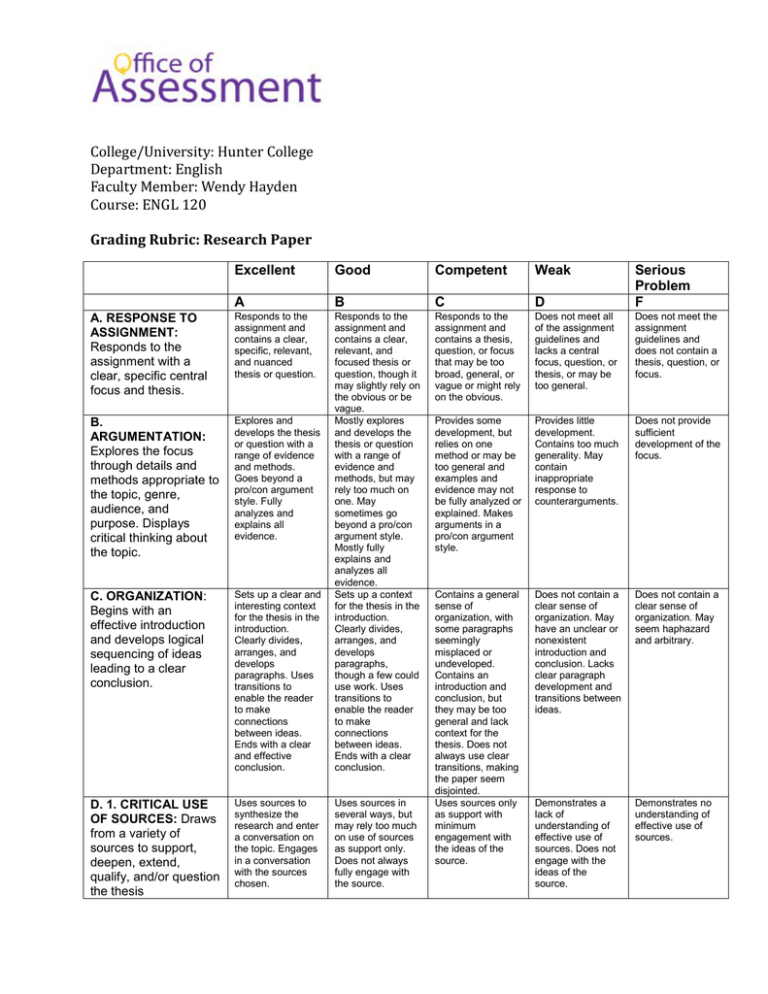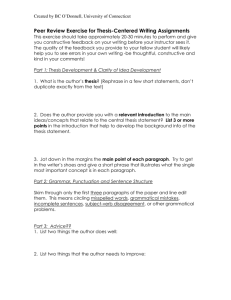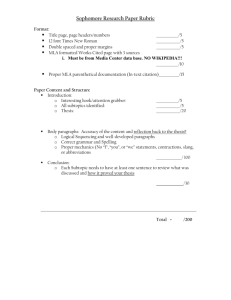College/University: Hunter College Department: English Faculty Member: Wendy Hayden
advertisement

College/University: Hunter College Department: English Faculty Member: Wendy Hayden Course: ENGL 120 Grading Rubric: Research Paper Excellent Good Competent Weak Serious Problem F A B C D A. RESPONSE TO ASSIGNMENT: Responds to the assignment with a clear, specific central focus and thesis. Responds to the assignment and contains a clear, specific, relevant, and nuanced thesis or question. Responds to the assignment and contains a thesis, question, or focus that may be too broad, general, or vague or might rely on the obvious. Does not meet all of the assignment guidelines and lacks a central focus, question, or thesis, or may be too general. Does not meet the assignment guidelines and does not contain a thesis, question, or focus. B. ARGUMENTATION: Explores the focus through details and methods appropriate to the topic, genre, audience, and purpose. Displays critical thinking about the topic. Explores and develops the thesis or question with a range of evidence and methods. Goes beyond a pro/con argument style. Fully analyzes and explains all evidence. Provides some development, but relies on one method or may be too general and examples and evidence may not be fully analyzed or explained. Makes arguments in a pro/con argument style. Provides little development. Contains too much generality. May contain inappropriate response to counterarguments. Does not provide sufficient development of the focus. C. ORGANIZATION: Begins with an effective introduction and develops logical sequencing of ideas leading to a clear conclusion. Sets up a clear and interesting context for the thesis in the introduction. Clearly divides, arranges, and develops paragraphs. Uses transitions to enable the reader to make connections between ideas. Ends with a clear and effective conclusion. Responds to the assignment and contains a clear, relevant, and focused thesis or question, though it may slightly rely on the obvious or be vague. Mostly explores and develops the thesis or question with a range of evidence and methods, but may rely too much on one. May sometimes go beyond a pro/con argument style. Mostly fully explains and analyzes all evidence. Sets up a context for the thesis in the introduction. Clearly divides, arranges, and develops paragraphs, though a few could use work. Uses transitions to enable the reader to make connections between ideas. Ends with a clear conclusion. Does not contain a clear sense of organization. May have an unclear or nonexistent introduction and conclusion. Lacks clear paragraph development and transitions between ideas. Does not contain a clear sense of organization. May seem haphazard and arbitrary. D. 1. CRITICAL USE OF SOURCES: Draws from a variety of sources to support, deepen, extend, qualify, and/or question the thesis Uses sources to synthesize the research and enter a conversation on the topic. Engages in a conversation with the sources chosen. Uses sources in several ways, but may rely too much on use of sources as support only. Does not always fully engage with the source. Contains a general sense of organization, with some paragraphs seemingly misplaced or undeveloped. Contains an introduction and conclusion, but they may be too general and lack context for the thesis. Does not always use clear transitions, making the paper seem disjointed. Uses sources only as support with minimum engagement with the ideas of the source. Demonstrates a lack of understanding of effective use of sources. Does not engage with the ideas of the source. Demonstrates no understanding of effective use of sources. D. 2. Choice of Sources Cites a variety of sources in terms of point of view expressed and type of source, which are appropriate for the topic and purpose. Cites a variety of sources, but relies too much on certain views or types of sources, though they are appropriate for the topic and purpose. D. 3. Integration and Attribution of Sources Demonstrates knowledge of when and how to incorporate quotation, paraphrase, and summary. Integrates sources effectively and uses proper attribution according to MLA conventions. Varies between quotation, paraphrase, and summary. There may be places where a source could be better integrated or explained. Uses proper attribution according to MLA conventions E. STYLE AND GRAMMAR: Uses style appropriate to the topic, genre, audience, and purpose. Demonstrates knowledge of grammatical and mechanical conventions. Uses clear, concise style appropriate to an academic context. Contains few, if any, grammatical or mechanical errors that distract the reader or compromise clarity. Uses clear and mostly concise style. May be wordy or unclear in places. Is relatively free of grammatical or mechanical errors that do not show inadequate knowledge of sentence structure or compromise clarity. Cites too many similar type of sources in terms of point of view and type of source. Relies too much on certain kinds of sources and may not use the best sources for the topic and purpose. Relies too much on quotation. Sources not always integrated effectively. Effort is made at proper attribution according to MLA conventions. Cites sources that meet the minimum requirements of the assignment. Sources chosen are not the best for the topic and purpose Does not meet the minimum requirements of a research paper in terms of sources chosen. May use long, irrelevant quotations or fail to integrate quotations effectively. Attribution is confusing. There may be places where it is unclear what material came from what source, though it is clear the paper is not intentionally plagiarizing. Does not show understanding of integration of sources. Quotations dropped-in, unexplained, or unclear. Unclear attribution may be bordering on plagiarism. Uses clear style, but may lack concision and preciseness. May have errors that show inadequate knowledge of sentence structure and compromise clarity. Uses general and unclear language. Makes grammatical and mechanical errors that make it hard to understand the meaning of the sentences. Contains so many grammatical errors that much of the paper is incomprehensible.

